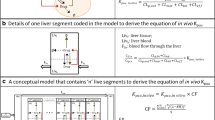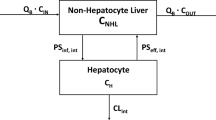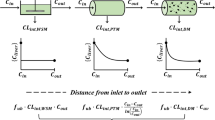Abstract
For a drug with concentration-dependent serum protein binding, the unbound fraction of drug decreases during the drug elimination process. The clearance of the drug at a given blood flow rate is lower than would be expected from the observed unbound fraction in venous blood from a noneliminating organ. Based on both the “well-stirred” and “parallel tube” models, simulations demonstrated that consideration of concentration-dependent binding during drug elimination is important when the intrinsic clearance is higher than the blood flow and when the unbound drug concentration is much greater than the dissociation equilibrium constant of the binding complex.
Similar content being viewed by others
References
M. Rowland, L. Z. Benet, and G. G. Graham. Clearance concepts in pharmacokinetics.J. Pharmacokin. Biopharm. 1:123–136 (1973).
G. R. Wilson and D. G. Shand. A physiologic approach to hepatic drug clearance.Clin. Pharmacol. Ther. 18:377–390 (1975).
K. Winkler, L. Bass, S. Keiding, and N. Tygstrup. The effect of hepatic perfusion on the assessment of kinetic constant. In F. Lundquist and N. Tygstrup (eds.),Regulation of Hepatic Metabolism. Academic Press, New York, 1974.
K. Winkler, S. Keiding, and N. Tygstrup. Clearance as a quantitative measure of liver function. In G. Paumgartner and R. Preisig (eds.),The Liver. Quantitative Aspects of Structure and Function. S. Karger, New York, 1973.
K. S. Pang and M. Rowland. Hepatic clearance of drugs. I. Theoretical considerations of a “well-stirred” model and a “parallel tube” model. Influence of hepatic blood flow, plasma and blood cell binding, and the hepatocellular enzymatic activity on hepatic drug clearance.J. Pharmacokin. Biopharm. 5:625–653 (1977).
J. R. Gilette and K. S. Pang. Theoretic aspects of pharmacokinetic drug interactions.Clin. Pharmacol. Ther. 22:623–639 (1977).
J. A. Jansen. Influence of plasma protein binding kinetics on hepatic clearance assessed from a “tube” model and a “well-stirred” model.J. Pharmacokin. Biopharm. 9:15–26 (1981).
P. A. Castleman, D. H. Russell, F. N. Webb, C. A. Hollister, J. R. Siegel, S. R. Zdonik, and D. M. Fram. The implementation of the PROPHET system.Natl. Computer Conf. Exp. Proc. 43:457–468 (1974).
P. J. McNamara, G. Levy, and M. Gibaldi. Effect of plasma protein and tissue binding on the time course of drug concentration in plasma.J. Pharmacokin. Biopharm. 7:195–206 (1979).
S. Øie, T. W. Guentert, and T. N. Tozer. Effect of saturable binding on the pharmacokinetics of drugs: a simulation.J. Pharmacy Pharmacol. 32:471–477 (1980).
Author information
Authors and Affiliations
Additional information
Supported in part by Grant GM 28423 from the National Institutes of General Medical Sciences, NIH.
Rights and permissions
About this article
Cite this article
Huang, J.d., Øie, S. Hepatic elimination of drugs with concentration-dependent serum protein binding. Journal of Pharmacokinetics and Biopharmaceutics 12, 67–81 (1984). https://doi.org/10.1007/BF01063611
Received:
Revised:
Published:
Issue Date:
DOI: https://doi.org/10.1007/BF01063611




